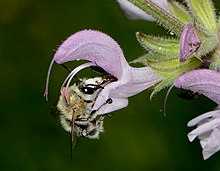| Salvia hierosolymitana | |
|---|---|

| |
| Scientific classification | |
| Kingdom: | Plantae |
| Clade: | Tracheophytes |
| Clade: | Angiosperms |
| Clade: | Eudicots |
| Clade: | Asterids |
| Order: | Lamiales |
| Family: | Lamiaceae |
| Genus: | Salvia |
| Species: | S. hierosolymitana
|
| Binomial name | |
| Salvia hierosolymitana | |
| Synonyms[1] | |
|
Salvia hierosolymitana var. chlorocalycina (Bornm.) Feinbrun | |
Salvia hierosolymitana is a species of flowering plant in the family Lamiaceae.[1][2] It is a herbaceous perennial commonly called Jerusalem salvia or Jerusalem sage that is native to the eastern Mediterranean, with populations in Cyprus, Israel, Jordan, Lebanon, Syria, and the West Bank.[3][4] It typically grows in open fields, rocky soils, and among low-growing native shrubs. It was first described in 1853 by botanist Pierre Edmond Boissier, with the epithet "hierosolymitana" referring to "royal, sacred Jerusalem".
It forms a mound of basal leaves that spreads to 2 ft, and slightly less in height. The ovate mid-green leaves are evergreen, lightly covered with hairs, and with a scalloped margin, growing 8–10 in long with prominent veining underneath. The 1 in or smaller flowers are a wine-red color, growing in widely spaced whorls, with 2-6 flowers per whorl. The lower lip is white, with wine-red spotting. The calyces are pea-green with red veins and bracts edged in red. The square stem of the 1 ft long inflorescences are also edged in red. Unlike many salvias, there is no odor when the leaves are crushed, and there is no known medicinal use of this plant.[5]

In Palestinian cuisine, the leaves are being stuffed with meat and rice then cooked with lamb riblets.
- ^ a b "Salvia hierosolymitana Boiss". Plants of the World Online. The Trustees of the Royal Botanic Gardens, Kew. n.d. Retrieved September 6, 2020.
- ^ "Salvia hierosolymitana Boiss". World Flora Online. The World Flora Online Consortium. n.d. Retrieved September 6, 2020.
- ^ "Salvia hierosolymitana". Germplasm Resources Information Network. Agricultural Research Service, United States Department of Agriculture. Retrieved 2 August 2010.
- ^ Ali-Shtayeh, Mohammed S; Rana M Jamous; et al. (2008). "Traditional knowledge of wild edible plants used in Palestine (Northern West Bank): A comparative study". Journal of Ethnobiology and Ethnomedicine. 4 (13). BioMed Central Ltd.: 13. doi:10.1186/1746-4269-4-13. PMC 2396604. PMID 18474107.
- ^ Clebsch, Betsy; Barner, Carol D. (2003). The New Book of Salvias. Timber Press. p. 145. ISBN 978-0-88192-560-9.